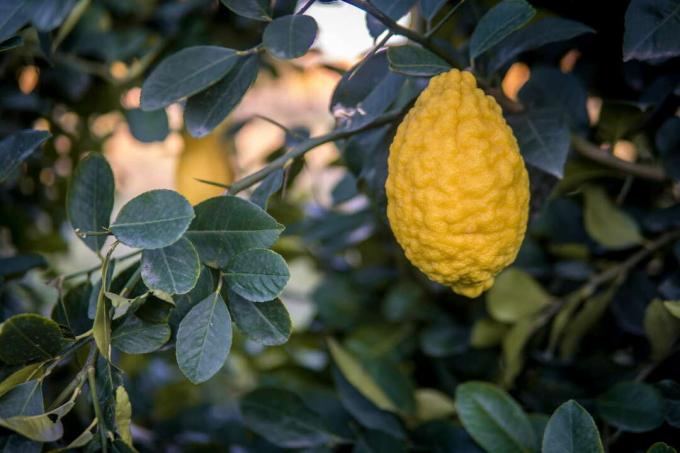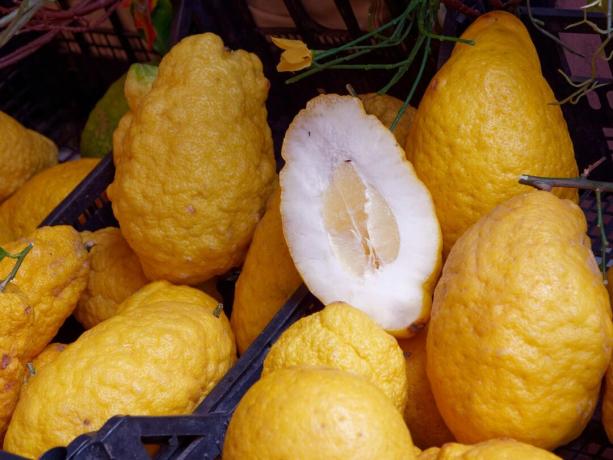The Italians call citron cedro. The special type of lemon from the Far East is becoming increasingly popular in this country.

Especially in the winter months, you can buy a real treasure from specialized greengrocers: the royal-looking citron (Citrus medica) – also called Cedro by the Italians. Even if it does not immediately attract admiration with its gnarled skin at first sight, the intense scent and aromatic taste of the handball-sized fruit are convincing. Find out below where the citron comes from and what else it has to offer.
contents
- Origin of the citron/Cedro
- Characteristics of citron/cedro
- Use of citron/cedro in the kitchen
Origin of the citron/Cedro
The origin of the citron is assumed to be in Southeast Asia or at the foot of the Himalayas. What is certain is that the cedro is one of the oldest citrus species, along with the tangerine and the pomelo. In historical records, the fruits can be found in a wide variety of places: in writings by Alexander the Great discovered the Cedro during the conquest of the Old Persian Empire and categorized. With the conquest of Jerusalem, citrons found their way to Europe, with migrants bringing planting material to Spain and southern Europe. Later, some of the migrants settled in Calabria and Sicily, which is still one of the main growing areas of Cedri today.
In Buddhism and Judaism, a ritual meaning is attributed to the intensely fragrant fruits. While Jews use pristine citron as etrog for the Feast of Tabernacles, Buddhists add the fruits of the Buddha's Hand variety to altar offerings. In Chinese customs, the cedro stands for health, happiness and contentment and is often given as a gift on New Year's Day.

More information about the extraordinary citron variety Buddha's hand and their use can be found here in our special article.
Characteristics of citron/cedro
Anyone who likes the fresh taste and smell of lemons will really love Cedro. Because not only the blossoms have an intense, fruity and fresh scent, but also their leaves, the wood and the fruits that ripen in winter, which can remain on the tree for weeks. Similar to lavender flowers, the fruits are also used as a room fragrance and in wardrobes.
Use of citron/cedro in the kitchen
In upscale gastronomy, the peel is mostly used to taste and decorate various dishes, but recently the pulp has also been used. This is surrounded by a thick layer of white mesocarp, so that the proportion of pulp is relatively manageable.
For the cedri carpaccio that is so popular in southern Italy, the fruits, which can weigh up to four kilos, are thoroughly grown and cut into thin slices. The slices are placed on a large plate and drizzled with salt, pepper and good quality olive oil. The cedri carpaccio can be combined with a wide variety of side dishes such as radicchio, prawns or grilled pork fillet.

In another form of preparation, the slices of cedro are sprinkled with salt and plenty of olive oil. Buffalo mozzarella wrapped in a cedar leaf is put in the oven for a few minutes at 220 °C and the grill function is activated. The buffalo mozzarella warms up and the cedro leaf develops wonderful roasted aromas. The cedro slice is then garnished with the mozzarella.
In addition to being used as a starter and to taste main dishes, on the western shore of Lake Garda, cedro is made into a fantastic lemonade. The cultivation and processing of Cedri has a long tradition in Saló. This is where the cedrata is born, known for its aroma and refreshing taste. Furthermore, jam, liqueur and, of course, citron are made from citron. Extracted scents from the cedro peel can also be found in expensive perfumes.
If you are looking for more extraordinary citrus fruits If you are interested, you can read more here.



